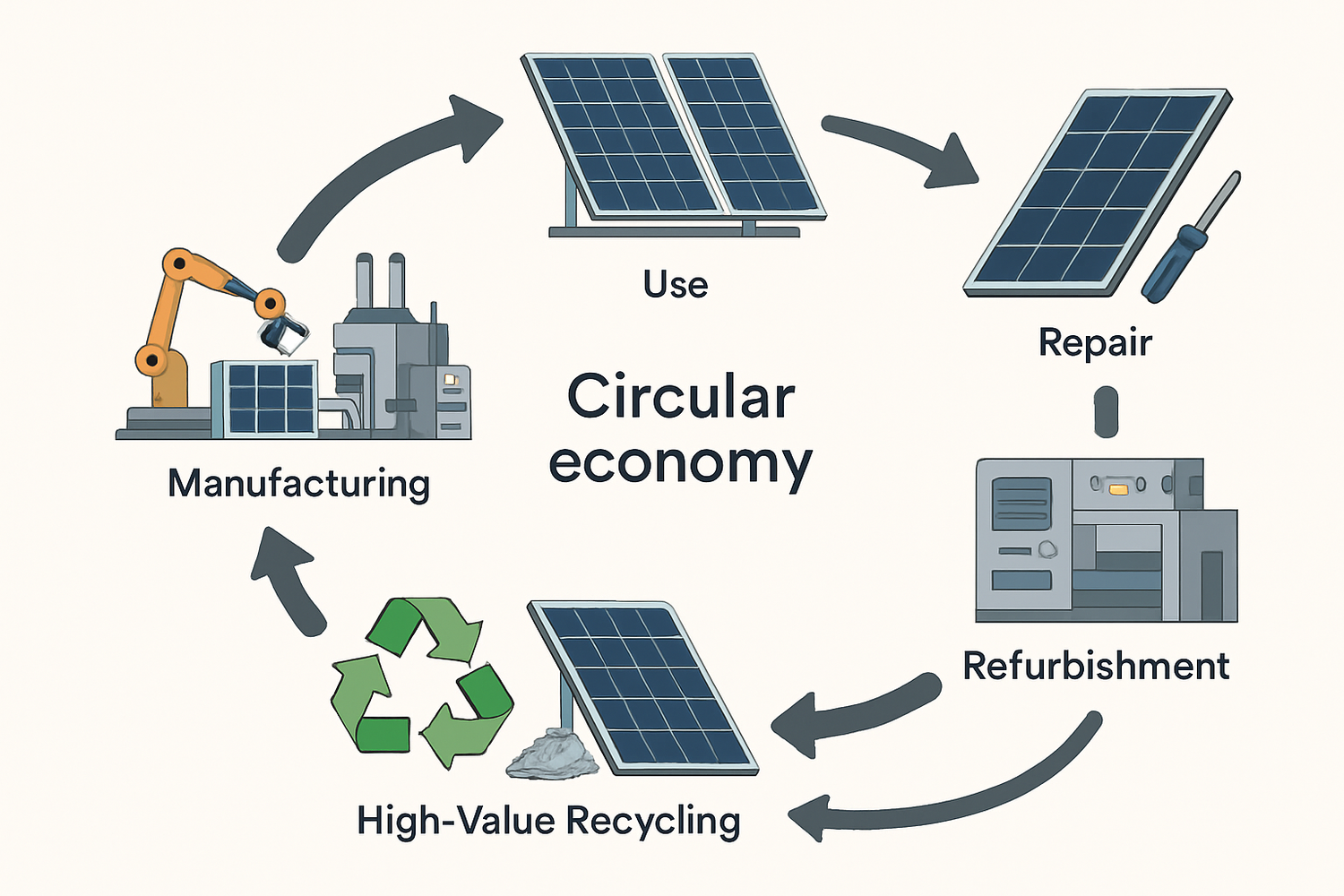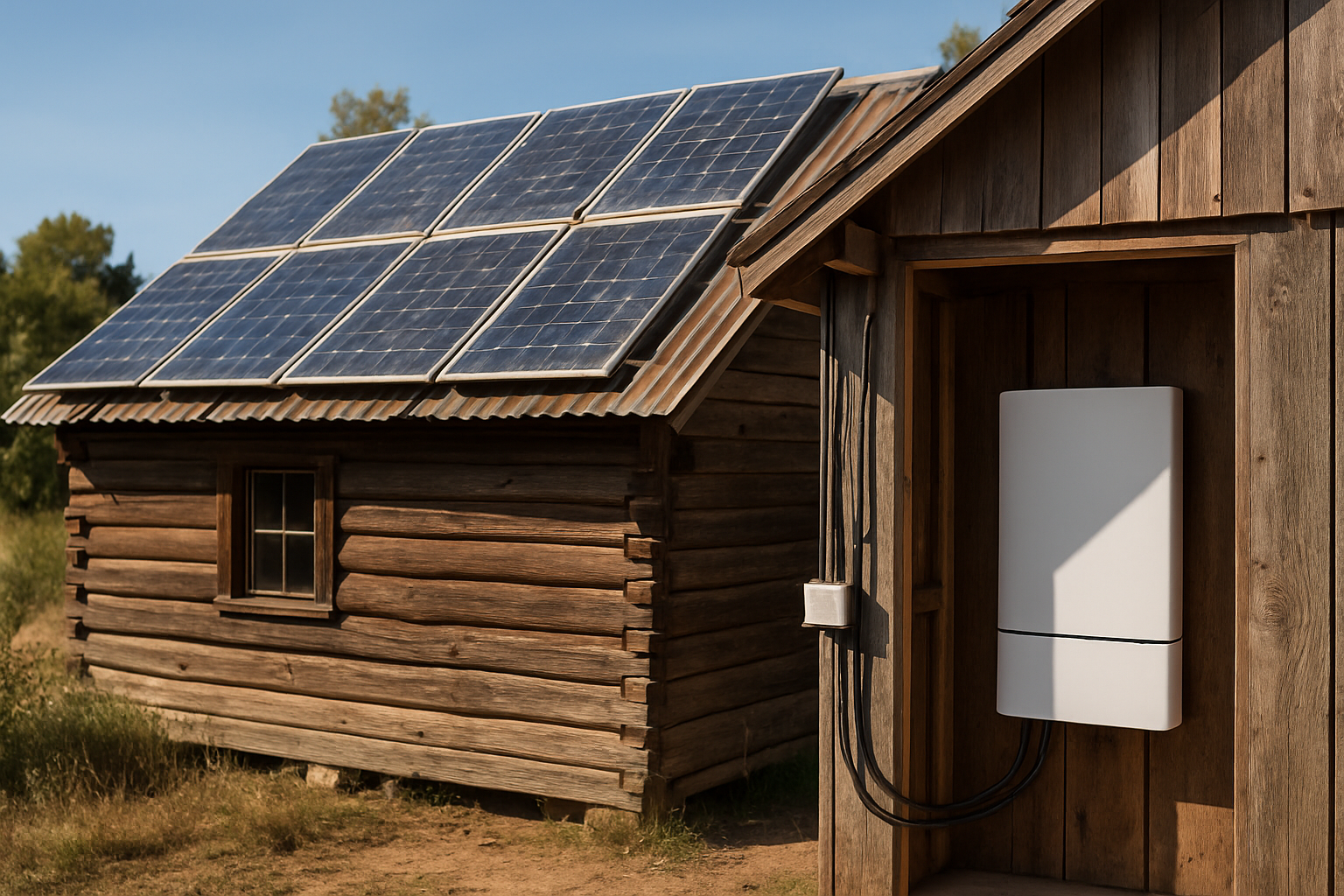The rapid expansion of solar energy is a cornerstone of global decarbonization efforts. As we install millions of photovoltaic (PV) modules, we must also plan for their end-of-life. A circular economy offers a strategic framework to manage this challenge, turning potential waste into a valuable resource. This approach is not merely about recycling; it's a comprehensive roadmap for Photovoltaic Lifecycle Management that strengthens the entire solar industry and accelerates progress toward net-zero emissions.
Understanding the Lifecycle of Solar Modules
To build a circular system, we first need to understand the journey of a solar panel. The traditional model is linear: extract raw materials, manufacture the product, use it, and then discard it. Shifting to a circular model requires rethinking each stage of this process, from initial design to final decommissioning.
Material Composition of Different Module Types
The materials inside a solar panel determine how it can be repaired, reused, or recycled. The two most common types of PV modules have distinct compositions, which presents different opportunities and challenges for circularity.
- Crystalline Silicon (c-Si) Modules: These are the most prevalent panels on the market. They primarily consist of an aluminum frame, high-purity glass, silicon wafers, and polymer encapsulants and backsheets. They also contain valuable conductive metals like copper and silver.
- Thin-Film Modules: This category includes technologies like Cadmium Telluride (CdTe) and Copper Indium Gallium Selenide (CIGS). While they also use glass, their semiconductor layers are different and can contain critical materials. Their construction often requires specialized recycling processes to recover these elements safely and efficiently.
| Component | Crystalline Silicon (c-Si) | Thin-Film (e.g., CdTe) |
|---|---|---|
| Glass | ~75% | ~90% |
| Aluminum Frame | ~10% | Varies (often frameless) |
| Silicon | ~5% | Negligible |
| Polymers (Encapsulant/Backsheet) | ~10% | ~5% |
| Semiconductor & Metals | Copper, Silver | Cadmium Telluride, etc. |
From Manufacturing to Decommissioning
A panel's lifecycle begins long before it reaches a rooftop. It starts with mining raw materials like quartz for silicon and bauxite for aluminum. The manufacturing process is energy-intensive, creating a carbon footprint that circular strategies can help reduce. During its operational life of 25-30 years, a panel generates clean energy. At decommissioning, we face a critical choice: landfill or circularity. The International Renewable Energy Agency (IRENA) projects that cumulative solar panel waste could reach 78 million tonnes by 2050. A circular approach ensures the valuable materials in these panels are recovered and reintroduced into the economy.
Core Strategies for Solar Module Circularity
A successful Net-Zero Roadmap depends on implementing a multi-faceted circularity strategy. This involves prioritizing actions that retain the highest value for the longest time, moving beyond simple disposal to create a regenerative system.

Extending Lifespan: Repair and Refurbishment
The most effective circular strategy is to keep products in use for as long as possible. Many panels retired from primary installations still have significant operational life left. Repairing minor damage, such as replacing a faulty junction box or fixing a cracked frame, can extend a module's lifespan. Refurbished panels can then be sold on a secondary market, providing affordable clean energy for different applications and delaying the need for recycling.
High-Value Recycling: Beyond Downcycling
When a panel truly reaches the end of its life, the goal is to recover materials at their highest purity. Early recycling methods often involved shredding panels and using the mixed materials as low-grade construction filler—a process known as downcycling. Modern, high-value recycling processes focus on delamination—the separation of the panel's layers. This allows for the recovery of intact glass, high-purity silicon, and valuable metals like silver and copper, which can be used to manufacture new solar panels or other high-tech products.
Designing for the Future: Circular-Ready Modules
The next frontier in Solar Module Circularity is designing panels with their end-of-life in mind. This concept, known as Design for Disassembly, involves using materials and construction techniques that make it easier to take panels apart. Examples include using reversible adhesives instead of permanent laminates or designing frames that can be unbolted without damaging other components. This forward-thinking approach will dramatically lower the cost and increase the efficiency of future recycling efforts.
The Economic and Environmental Case for Circularity
Adopting a circular economy for solar is not just an environmental imperative; it is also a significant economic opportunity. It builds resilience, reduces environmental impact, and creates new lines of business within the green economy.
Securing Critical Material Supply Chains
The transition to clean energy is increasing demand for specific raw materials. As the IEA has noted in its technology roadmaps, the growth of PV is immense. Recycling end-of-life panels creates a domestic source of critical materials, reducing dependence on volatile international markets and the environmental impact of mining. This 'urban mining' of old modules strengthens supply chain security and helps stabilize material costs for manufacturers.
Reducing Carbon Footprint and Waste
Recycling materials consumes far less energy than extracting and processing virgin resources. For example, recycling aluminum requires up to 95% less energy than producing it from bauxite ore. By recovering and reusing materials from old solar panels, the industry can significantly lower the overall carbon footprint of solar energy. As a report on end-of-life management from the National Renewable Energy Laboratory (NREL) highlights, proper management is crucial to minimize waste and maximize resource utilization.
Building the Ecosystem for a Circular Solar Industry
A successful transition to a circular economy requires a supportive ecosystem of policy, infrastructure, and collaboration across the value chain. No single company can build this alone; it requires a concerted effort.
The Role of Policy and Regulation
Government policies can accelerate the adoption of circular practices. Frameworks like Extended Producer Responsibility (EPR) require manufacturers to finance and manage the collection and recycling of their products at the end of life. Additionally, streamlining permitting for recycling facilities is essential. As detailed in a U.S. Department of Energy success story, slashing red tape helped speed solar deployment, and a similar approach can foster the growth of recycling infrastructure.
Developing Reverse Logistics and Infrastructure
One of the biggest practical challenges is creating an efficient system for collecting, transporting, and processing end-of-life panels. This 'reverse logistics' network requires specialized collection centers, safe transportation methods, and advanced recycling facilities. Investment in this infrastructure is critical to handle the growing volume of decommissioned panels and make recycling economically viable on a large scale.
Your Role in the Circular Transition
Everyone in the solar ecosystem has a part to play in advancing the circular economy. From individual system owners to large-scale developers, conscious choices can drive the industry toward greater sustainability.
For System Owners and Operators
When purchasing a solar system, inquire about the manufacturer's commitment to sustainability and their end-of-life plans. Prioritize proper maintenance to maximize the system's lifespan. When it is time for an upgrade or decommissioning, seek out certified recyclers instead of sending panels to a landfill.
For Installers and Developers
You are on the front lines of the industry. You can educate customers about the importance of lifecycle management. By partnering with reputable recycling firms, you can offer take-back services that add value to your business and ensure panels are handled responsibly. Your choices can help shape a more sustainable market.
Looking Ahead: The Future of Solar Circularity
The path to a net-zero energy system is paved with innovation. Creating a circular economy for solar modules is a vital part of this journey. It transforms a potential waste problem into a strategic opportunity for resource security, economic growth, and deeper decarbonization. By extending product lifespans, recovering valuable materials, and designing for the future, we can ensure that solar energy is truly sustainable for generations to come. This roadmap provides the framework for building a resilient, regenerative, and powerful solar industry.
Frequently Asked Questions
What is solar module circularity?
Solar module circularity is an economic model focused on eliminating waste and maximizing the value of resources. Instead of a 'take-make-dispose' model, it emphasizes repairing, refurbishing, reusing, and recycling solar panels and their components to keep them in the economic loop for as long as possible.
Can all types of solar panels be recycled?
Most photovoltaic panels can be recycled, but the processes and efficiency vary by technology. Crystalline silicon panels are widely recycled, with high recovery rates for glass and aluminum. Thin-film modules require more specialized processes to recover their specific semiconductor materials, but dedicated facilities exist to handle them effectively.
Who is responsible for recycling old solar panels?
Responsibility can vary by region. In some areas with Extended Producer Responsibility (EPR) laws, manufacturers are financially responsible. In other cases, the system owner is responsible for finding a certified recycler. As the industry matures, a combination of manufacturer-led programs and specialized recycling companies is emerging to manage this process.
Does recycling solar panels make economic sense?
Yes, and the business case is strengthening. As recycling technologies improve, the efficiency of material recovery increases. The rising value of raw materials like silver, copper, and high-purity silicon makes recovery more profitable. Furthermore, regulations and landfill costs make recycling a more financially sound decision compared to disposal.





Leave a comment
All comments are moderated before being published.
This site is protected by hCaptcha and the hCaptcha Privacy Policy and Terms of Service apply.